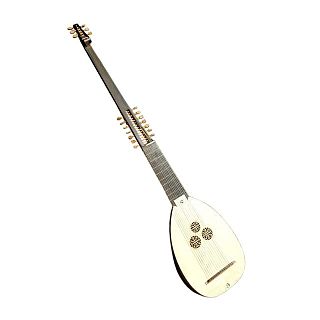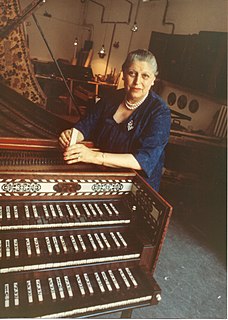Related Research Articles

The theorbo is a plucked string instrument of the lute family, with an extended neck and a second pegbox. Like a lute, a theorbo has a curved-back sound box with a wooden top, typically with a sound hole, and a neck extending out from the soundbox. As with the lute, the player plucks or strums the strings with one hand while "fretting" the strings with the other hand; pressing the strings in different places on the neck produces different pitches (notes), thus enabling the performer to play chords, basslines and melodies.

Marin Marais was a French composer and viol player. He studied composition with Jean-Baptiste Lully, often conducting his operas, and with master of the bass viol Monsieur de Sainte-Colombe for six months. In 1676 he was hired as a musician to the royal court of Versailles and was moderately successful there, being appointed in 1679 as ordinaire de la chambre du roy pour la viole, a title he kept until 1725.

Le Poème Harmonique is a musical ensemble founded in 1998 by Vincent Dumestre to recreate and promote early music, in particular that of the 17th century. Using rare instruments such as the theorbo, the lirone, the tiorbino and the arpa tripla, Le Poème Harmonique aims to recapture the poetry of early music, particularly of the late renaissance and early baroque era. The early 17th-century French and Italian madrigal is a special interest. Le Poème Harmonique also teaches singers in collaboration with the Centre de Musique Baroque at Versailles. The group's recordings with the French Alpha record label of Jean-Paul Combet contributed to the critical and commercial establishment of the label, and included the 1st and 100th releases of the label's primary 'Ut Pictura Musica' series.
Giovanni Girolamo Kapsperger was an Austrian-Italian virtuoso performer and composer of the early Baroque period. A prolific and highly original composer, Kapsberger is chiefly remembered today for his lute and theorbo (chitarrone) music, which was seminal in the development of these as solo instruments.
A tombeau is a musical composition commemorating the death of a notable individual. The term derives from the French word for "tomb" or "tombstone". The vast majority of tombeaux date from the 17th century and were composed for lute or other plucked string instruments. The genre gradually fell out of use during the 18th century, but reappeared in the early 20th.

Robert de Visée was a lutenist, guitarist, theorbist and viol player at the court of the French kings Louis XIV and Louis XV, as well as a singer and composer for lute, theorbo and guitar.

The Baroque guitar is a string instrument with five courses of gut strings and moveable gut frets. The first course sometimes used only a single string.

The angélique is a plucked string instrument of the lute family of the baroque era. It combines features of the lute, the harp, and the theorbo.

Adrian Le Roy (c.1520–1598) was an influential French music publisher, lutenist, mandore player, guitarist, composer and music educator.

Geneviève, comtesse Hubert de Chambure Thibault was a French musicologist associated with the revival of interest in early music. She graduated from the Sorbonne in 1920 with a thesis on John Dowland, and then continued the work with André Pirro on her doctoral thesis on the fifteenth-century chanson, which she never completed. In 1925 co-founded the Société de musique d'autrefois, designed to promote the publication de musical texts and a magazine les Annales musicologiques. After her marriage in 1931 she stopped musical and scholarly activities, gave birth to six children, and alternated her life between Vietnam and France. After the death of her husband Hubert Pelletier de Chambure (1903-1953), she returned permanently to Paris, where in June 1953 she resumed her scholarly activities and organization of concerts. From 1961 to 1973, she was curator of the historical instrumentals of the Conservatoire de Paris - in addition to having amassed her own private collection. She was an important muse and teacher to the first generation of baroque specialists, including young Americans in Paris - William Christie (harpsichordist) and soprano Judith Nelson.
Charles-Émilien Thuriet was a 19th–20th-century French writer and poet.
Christopher Wilke is an American composer, lutenist, guitarist, recording artist, and teacher.
Jean Boyer was a French viol player and composer, active in Paris during the first half of the 17th century.
François Porcile is a French film director, essayist, film historian and musicologist.
Henri Quittard was a French composer, musicologist and music critic.
Antoine Francisque was a 16th-century French lutenist and composer.
Jonathan Dunford is an American violist specialising in the baroque repertoire.

François Lesure was a French librarian and musicologist.
Marie Bobillier, real name Antoinette Christine Marie Bobillier was a French musicologist, music critic, writing under her pseudonym Michel Brenet.
Alain Damiens is a French classical clarinetist.
References
- 1 2 3 David Ledbetter, Grove Music Online, mentioned by Oxford Index
- ↑ Charles Hurel, data.bnf.fr
- ↑ Lute Society of America Quarterly, Volume 43, The Society, 2008, (p. 38).
- 1 2 3 The Journal of the Lute Society, Volumes 35 à 39, Lute Society, 1997 (p. 189).
- 1 2 Claudia Knispel, Beiträge zur Geschichte der Lautenistinnen und Gitaristinnen der Renaissance und des Barock, Kassel University Press, 2014, p. 79.
- ↑ Archives Nationales - Minutes et répertoires du notaire Olivier Gaultier
- ↑ Alexandre Gady, Poutres et solives peintes. Le plafond « à la française », Revue de l'Art, Volume 122 , 1998, (p. 13).
- ↑ Claudia Knispel, (opcit), (p. 183)
- ↑ Guitar and Lute Handbook, Schott, 2003, p. 203.
- ↑ Albert James Diaz, Ann S. Davis, Guide to Reprints, Microcard Editions, 1996, (p. 443).
- ↑ Mémoire vive - Patrimoine numérisé de Besançon
- ↑ Catalogue de la bibliothèque du Centre de musique baroque de Versailles
- ↑ (in Spanish) Fuentes barroco